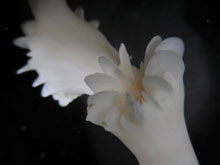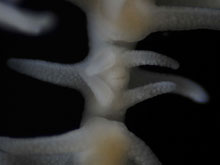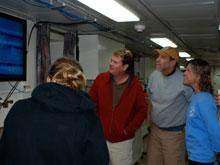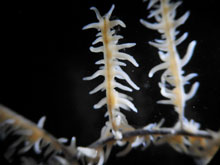Cheryl Morrison (far right) and other members of the science party watch as seafloor imagery appears on the monitor in the main lab. Click image for larger view and image credit.
Deepwater Corals 101
August 21, 2009
Cheryl Morrison
Conservation Geneticist
U.S. Geological Survey
Since about 8:00 last evening, the remotely operated vehicle (ROV) Jason has been working at our first dive site on the continental slope off the coast of southwestern Florida. By 9 p.m., the images were coming in on the various monitors around the ship, and I was so excited to see our first Lophelia pertusa at this new dive site! These could be a missing link for us.
From our studies of genetic connectivity among L. pertusa populations in the northern Gulf of Mexico and western Atlantic Ocean, we’ve learned that there is limited dispersal of larvae between these ocean regions. Although they are the same species, the populations are differentiated. Today’s site lies in between our previous L. pertusa collections. When we add genetic data from the samples we collect here, we may be able to pinpoint where this break in connectivity occurs. This information is useful when designing effective management schemes to protect these fragile ecosystems.

A close-up of a Lophelia pertusa calyx, with the polyp retracted. Click image for larger view and image credit.
At this new site, we’ve seen all of the major varieties of deep-sea corals, including stony corals (Scleractinia), such as Lophelia pertusa; soft corals (Octocorallia), including gorgonian sea fans and bamboo corals; black corals (Antipatharia); and hydrocorals (Stylasteridae). These corals are animals in the Phylum Cnidaria, which includes jellyfishes and anemones, but the corals have either calcium carbonate or horn-like skeletons that distinguish them from other cnidarians.
Unlike their more familiar coral cousins that live in shallow waters where sunlight is prevalent, deep-sea corals inhabit cold — 4 to 12°C (39 to 54ºF) — and dark waters; and, as a result, they do not have photosynthetic symbionts (zooxanthellae) that produce food. Instead they rely on capturing food (plankton) from the water using their nematocysts (stinging cells) and often live in areas of high bottom currents that deliver plankton and remove sediment. Deep-sea corals can be found on topographic high areas such as mounds or walls on continental shelves, slopes, and seamounts worldwide.
Nearly half of known stony coral species live in deep water
Most people don’t realize that about 41% of all known stony coral species live in deep water, deeper than 50 meters (163 feet) and out of the photic zone. At present, we know of 1,482 species of stony corals in the world’s oceans (Cairns, 2007). The majority of these deep-corals are solitary and live attached to hard substrate.
Over 60 species of stony corals occur in the deep Gulf of Mexico. The most diverse assemblages of Gulf corals are in this region adjacent to the Atlantic and Caribbean oceans. Lophelia pertusa is a colonial stony coral species found throughout most of the world’s oceans. In the Gulf of Mexico, L. pertusa is best known in the north-central region around Vioska Knoll, a site we’ll visit later in the cruise. As colonies grow, a framework is created that eventually becomes a reef-like structure. These reefs can be large in size, stand hundreds of meters off the sea floor, and are home to a variety of other animal species, such as squat lobsters, sea urchins, sponges, and fishes.

Note the mouth and six tentacles visible on this black coral (Leiopathes sp.) polyp. Click image for larger view and image credit.
The more we explore, the more we find
The more we explore the continental slopes in the Gulf and Atlantic Ocean, the more deep reefs we find. As enhanced maps of bottom topography (surface details) become available, we can make more accurate predictions about where L. pertusa reefs may occur. However, we still need to view these sites using submersibles or remote vehicles with imaging abilities to verify that corals are present. That’s why it’s exciting to be on this cruise using the sophisticated Jason II ROV.
Cairns S.D. (2007) "Deep-water corals: an overview with special reference to diversity and distribution of deep-water scleractinian corals." Bull. Mar. Sci. 81(3): 311-322.





























